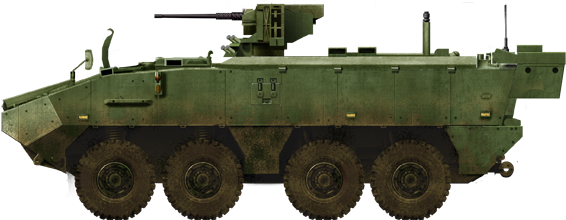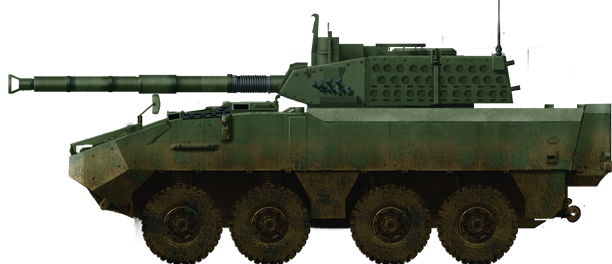The Belgian Piranhas
In 2006 Belgian Army ordered Swiss MOWAG Piranha IIIC in 8x8 configuration. They came in the basic armored personnel carrier variant and several sub-variants as per the armored infantry vehicle requirement of the Army as defined by the MoD in a context of budget constraints. A total of 242 vehicles were ordered, and this included many variants:- Piranha FUS: Base APC, 12.7 mm RWS, replacing the M113, 99 made by GDELS-Mowag.
- Piranha CP: (Command variant) Same in appearance but with more powerful radios, map table, etc. 24 made.
- Piranha RECOVERY: Fitted with full recovery gear on the roof (no armament), dozer blade forward and stretchers. 24 built.
- Piranha GENIE: Two types of dozer blades at the front, modified internal compartment, RWS kept. 18 Made.
- Piranha DF30: 30mm UT 30/ORCWS 30 RWS gun fire AA/G support variant, 32 Made.
- Piranha DF90: 90mm/48.5 heavy support variant, 40 ordered, 18 in service.
The basic Piranha IIIC APC has crew of three: Driver, seated next to the engine, Commander behind with a cupola, and gunner in the middle compartment. Up to 11 soldiers can seat in the troop compartment at best using rear doors, plus roof hatches for observation and firing on the move, extra hatches for exit if turned over. The standard powerplant is the robust Caterpillar C9 turbocharged diesel rated for 400 hp at the front-left, coupled with a German ZF 7-speed automatic gearbox. All eight wheels features independent suspension, so that the vehicle can loose one or two of these and still keep its mobility. These are run-flat tyres with a centralized inflation system. Belgian vehicles lacks the Amphibious capability, which is optional.
Specifics of the DF-90 Fire support variant

40 Piranha IIIC were modified in Belgium to accomodate the CMI Defence 90 mm turret, as decided to replace the Leopard 1A5BN in service with the Land Component. Other sources reports today 18 are in service, 22 vehicles optional for supplementary orders (nit converted). They are the same Piranha IIIC as the rest of the 242 order made to GLDS/Mowag but this version had a tailored turret, and the name signified "Direct Fire 90" according to the caliber. The first were delivered in 2008 but the remainder of the 40 initial orders were cancelled after the change of minister. Thus, 18+22 seems coherent.
The DF-90 fire support vehicle had the same advantages of compatibility with the rest of the family, a commonality chosen to replace both the M113 and Leopards in service. These vehicles are noted for their excellent strategic and tactical mobility, and by virtue of commonality, maintenance and support costs are lowered. The wheeled vehicles are recoignised for their speed and cost-effectiveness but this radically changes the tactical approach of the Belgian army, from a NATO counter-soviet style force to a light mobility force as seeked out with the experience of the gulf,and Afghanistan war, with an emphasis on mobility.
The DF 90 had been tailored to organically support other Piranha IIIC 8x8 armored vehicles with direct fire. The stryker brigade is one of the assumed model for the new model of Belgian armoured brigaded. They capitalize on speed, deployability and maneuverability to counter enemy forces, with immediate air support when encountering heavier resistance.
The brigade possesses a number of towed artillery, so the role of the DF 90 is rather direct support of infantry. The 90 mm was designed to be effective against lightly armored or soft skin targets. So the vehicle can deal with similar IFVs. It is also useful to reduced fortified positions in an urban theater. It is not meant to deal with main battle tanks (a source of critics against the retirement of the Leopards). The 90 mm is on the lower end of fire support vehicles, which usually mounts 105 mm or 120 mm guns (M1128, Centauro...). But these guns had been ruled out due to the lighter Pirhanha IIIC chassis, and issues with the recoil.
Main design features
The DF90 fire support vehicle features the same modular scaleable armor, the base being proof against small arms fire, the belly against mine blasts/IEDs to some extent, with modular add-on panels proof against RPGs. The naked hull is proof against 7.62 mm AP rounds and shrapnel, but the vehicle carries bolt-in armour panels. NBC protection, automatic fire suppression systems are standards for the engine and troop compartments. Disposition of the crew is the same, albeit the Commander and gunner are seated side by side in the turret, each with a read-folding round hatch.Mobility
The engine is the same standard Caterpillar C9 TD rated for 400 hp coupled with a ZF 7-speed automatic gearbox. The rest of the performances is close, if inferior due to added weight of the turret, compared to the base APC. Top speed on road is stated as 105 km/h, range in road conditions up to 600 km. The vehicle is able to climb a 60% slope, negociate a 30% side slope, climb a 0.6 m step and gap a 2m trench, of ford without preparation 1.5 m. Floatability is probably denied due to the weight of the turret and the vehicle is not rated not equipped for amphibious operations.Armament
The 6-panels CMI/Cockerill CMI Defence LCTS90 is a two-man turret, fitted on either forward panels with two banks of four smoke dischargers for active protection. The lain gun is the medium-pressure Cockerill Mk.8 90 mm, 48.5 calibers gun. It is loaded manually by the gunner, and is fully-stabilized in order to fire accurately on the move. The turret and this particular guns are a speciality of CMI, which is a world leader in this type. Maximum range of fire is about 2.2 km with an indirect range possible up to 7.8 km. CMI announced the gun was successfuly tested with the same caliber Ukrainian Falarick 90 anti-tank guided missile, with laser guidance. So far it seems the Belgian Army did not adopted it. However it will be a plus if the surplus vehicles are sent to Ukraine.In total, the DF 90 carries internally 37 rounds, 17 ready-rounds stored in the turret bustle (HE, HEAT) and a remaining 20 in other locations inside the turret. In addition to the main gun there is a coaxial 7.62 mm light machine gun plus a roof-mounted one, same model, GMPG. The fire control system comprises the panoramic commander's sight assorted with Ifntrared camera (magnification unknown) and the gunner's sight, plus a hunter-killer engagement capability.
Career and fate
As replacement for the Leopard 1A5BN, the Piranha IIIC DF 90 met a lot of criticism. Chief of which was the basic gun was a medium-pressure low-velocity ordnance that cannot match any of the Rheinmetall 105 mm's performances, as used on the 1A5. The caliber is also incompatible with the 105-120 mm range deployed today by NATO main battle tanks. It is relatively compatible however with older French vehicles such as the Panhard AML, AMX-10RC, SANDF Ratel, and vehicles in general featuring a similar low-pressure gun, albeit in detail the Cockerill is more recent and better performing. Worst still, the gun was said "compatible" with antitank ammunition such as HEAT and AFPSDS rounds, but it appeared later not to be the case. The fact was raised in reports in 2009-2010, and the issue was dropped entirely in 2015. The vehicle is thus only capable of anti-infantry or infantry support actions with its HE range.Export prospects: The LCTS90 turret is of course compatible with the Piranha III range, but was also designed to be mounted on other wheeled/tracked armored vehicles in the 10/20t weight class. It was of course presented in exhibitions at the time for export, and several contracts were obtained. It was fitted for example on the Kuwaitian Pandur 6x6 fire support vehicle, the Qatari and Saudi Arabian Piranha II 8x8 fire support vehicles. The turret had been superseded by the CT-CV two-man turret using this time a far more efficient high pressure 105 mm Cockerill CV gun with high First Hit Probability, compatible to all NATO 105mm ammunition, M1060CV ammunition, gun fired missiles, 42° elevation, BLS firing and ammunition rack with autoloader. Unfortunately there is no plan of upgrade of the current DF 90, apart the addition of ATGM canisters.
Links
militarytoday.combelgium sending 1/3 lancers battalion to romania 2022
warwheels.net
reddit.com
militarytoday.com
army-guide.com
joint-forces.com
Pirhana IIC DF90 specifications | |
| Dimensions | 7.77oa (Hull 7.57) x 2.72 x 2.93 m |
| Total weight, battle ready | 19.43 - 22.6 tons |
| Crew | 3 (driver, commander, gunner/loader |
| Propulsion | Caterpillar C9 diesel 400 hp, auto ZF gearbox |
| Suspension | 8x8 independent, shock absorbers |
| Speed (road) | 105 km/h |
| Range | 600 km |
| Armament | 90 mm/48.5 cannon (37 rds), 2 x 7.62 mm LMGs |
| Armor | Modular. Base proof vs. 7.62 mm AP/shrapnel, addon panels. |
| Total production | 40 in 1995-today |

Belgian Piranha IIIC APC

Belgian Piranha IIIC DF 90
Piranha IIIc: Belgium still possesses 18 Piranha III DF90 and 32 Piranha III DF30 IFVs, intended for replacement by the new 60 EBRC Jaguar, to be delivered in 2025 onwards.
Video
Gallery







Cold War Tanks


































Cold war tanks posters

Cold War Main Battle Tanks

Cold War Soviet Army
Museums, Movies, Books & Games
The Tanks and Armor in pop culture
Tanks and armored vehicles in general are only really grasped when seen first person: The mass, the scale, it's all there. Explore also the way tanks were covered in the movie industry, in books and in video games.Movies:
Best tanks movie on warhistoryonline.com
On imdb.com
On bestsimilar.com/
miltours.com
liveabout.com/
watchmojo.com
Video Games:
pcgamesn.com
historyhit.com
levvvel.com
vg247.com/best-tank-games
mmobomb.com/
alienwarearena.com

